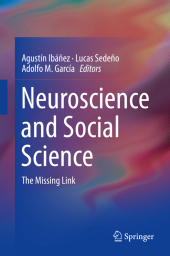 Neuerscheinungen 2017Stand: 2020-02-01 |
Schnellsuche
ISBN/Stichwort/Autor
|
Herderstraße 10
10625 Berlin
Tel.: 030 315 714 16
Fax 030 315 714 14
info@buchspektrum.de |

Adolfo M. García, Agustín Ibá¤ez, Lucas Sede¤o
(Beteiligte)
Neuroscience and Social Science
The Missing Link
Herausgegeben von Ibá¤ez, Agustín; Sede¤o, Lucas; García, Adolfo M.
1st ed. 2017. xviii, 546 S. 13 SW-Abb., 25 Farbabb. 235 mm
Verlag/Jahr: SPRINGER, BERLIN; SPRINGER INTERNATIONAL PUBLISHING 2017
ISBN: 3-319-68420-5 (3319684205)
Neue ISBN: 978-3-319-68420-8 (9783319684208)
Preis und Lieferzeit: Bitte klicken
This book seeks to build bridges between neuroscience and social science empirical researchers and theorists working around the world, integrating perspectives from both fields, separating real from spurious divides between them and delineating new challenges for future investigation. Since its inception in the early 2000s, multilevel social neuroscience has dramatically reshaped our understanding of the affective and cultural dimensions of neurocognition. Thanks to its explanatory pluralism, this field has moved beyond long standing dichotomies and reductionisms, offering a neurobiological perspective on topics classically monopolized by non-scientific traditions, such as consciousness, subjectivity, and intersubjectivity. Moreover, it has forged new paths for dialogue with disciplines which directly address societal dynamics, such as economics, law, education, public policy making and sociology. At the same time, beyond internal changes in the field of neuroscience, new problems emerge in the dialogue with other disciplines.
Neuroscience and Social Science - The Missing Link puts together contributions by experts interested in the convergences, divergences, and controversies across these fields. The volume presents empirical studies on the interplay between relevant levels of inquiry (neural, psychological, social), chapters rooted in specific scholarly traditions (neuroscience, sociology, philosophy of science, public policy making), as well as proposals of new theoretical foundations to enhance the rapprochement in question.
By putting neuroscientists and social scientists face to face, the book promotes new reflections on this much needed marriage while opening opportunities for social neuroscience to plunge from the laboratory into the core of social life. This transdisciplinary approach makes Neuroscience and Social Science - The Missing Link an important resource for students, teachers, and researchers interested in the social dimension of human mind working in different fields, such as social neuroscience, social sciences, cognitive science, psychology, behavioral science, linguistics, and philosophy.
Chapter 1: Exploring the borderlands of neuroscience and social science
Part I - Neuroscientific research on social cognition
Chapter 2: Valuing others: evidence from economics, developmental psychology, and neurobiology
Chapter 3: Bias and control in social decision-making
Chapter 4: Neurobiological approaches to interpersonal coordination: Achievements and pitfalls Chapter 5: The social neuroscience of attachment
Chapter 6: Mindreading in altruists and psychopaths
Chapter 7: From primary emotions to the spectrum of affect: An evolutionary neurosociology of the emotions
Chapter 8: Moral cognition and moral emotions
Chapter 9: On the cognitive (neuro)science of moral cognition: utilitarianism, deontology and the ´fragmentation of value´
Chapter 10: The social/neuro science: Bridging or polarizing culture and biology?
Part II - Impact of social neuroscience in social spheres
Chapter 11: Dementia and social neuroscience: Historical and cultural perspectives
Chapter 12: Clinical studies of social neuroscience: A lesion model approach
Chapter 13: Psychotherapy and social neuroscience: forging links together
Chapter 14: The brain in the public space: social neuroscience and the media
Part III - Integration of social and neuroscientific insights
Chapter 15: Electrophysiological approaches in the study of the influence of childhood poverty on cognition
Chapter 16: The cultural neuroscience of socioeconomic status
Chapter 17: Social ties, health and wellbeing: A literature review and model
Part IV - Philosophical contributions on theoretical, methodological, and ethical questions
Chapter 18: The self-domesticated animal and its study
Chapter 19: How is our self related to its brain? Neurophilosophical concepts
Chapter 20: Enaction and neurophenomenology in language
Chapter 21: A pluralist framework for the philosophy of social neuroscience
Chapter 22: Social neuroscience and neuroethics: a fruitful synergy


